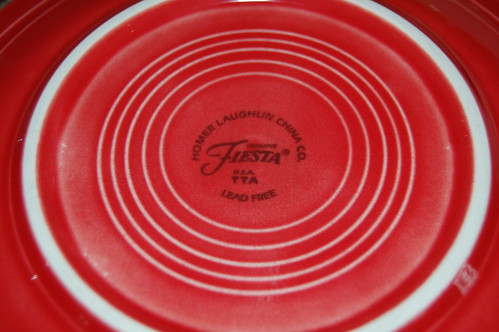Lead content is a bit of the redheaded stepchild of both vintage and contemporary dinnerware – including Fiesta. The fear among many consumers is that lead from the glaze can leach into your food and into your body and cause lead poisoning.
Homer Laughlin is well aware of this, and has since begun printing “Lead Free” on the bottoms of all of their Fiestaware. But what does “Lead Free” actually mean? What about cadmium? And should you be worried about Fiestaware that doesn’t bear a “Lead Free” label? The short answer to that last question is: “No.” But of course, if you’re frantically searching the Internet trying to figure out whether your beloved Fiestaware is safe for you and your kids to eat off of, then you’re probably looking for a more thorough explanation. Here it is:
FDA Lead and Cadmium Leaching Standards
According to FDA standards, lead levels for ceramic flatware (plates with a depth
Plastic – almost started. Different and 0.25 PPM for large hollow ware. One important thing to note about FDA standards is that they measure leachable lead and not lead content. What does this mean? Leachable lead is the amount that may enter into your food and thus your body. Lead content is the actual physical makeup of the product. So, in theory, you could have a plate that was made out of 100% lead but had some kind of magical glaze that prevented any of it from seeping into your food and that would have 0.0 PPM leachable lead and thus pass the FDA’s standards. This, of course, is an extreme example and most dinnerware has a combination of low lead content and low leach ability.
So, how does Fiestware stack up? A forum poster over at another website said that she emailed Homer Laughlin in 2007 about their cadmium content and they reported that their dinnerware tested for .02 PPM for lead and cadmium. So, technically, it’s not 100% lead free – as no China or dinnerware is – but it’s pretty darn close. Also, because Fiestaware is made in the USA, Homer Laughlin is compelled to follow FDA regulations. The real danger is from imported and low quality china, pottery and ceramics. Fiestaware is neither/nor.
“Lead Free” Labeling
So, when something reads “Lead Free” is it really? As we see with the example from Fiestaware, the answer is obviously not. Lead free refers more to the process and system by which the item is made and speaks less to the presence of any trace amount of lead. Homer Laughlin converted their factories to a lead free system and starting in 1986, they began touting their Fiesta as “Lead Free.”
Lead free systems require cleaned or new kilns (lead from previous firings may leech into new products otherwise) and the type of glaze, decal and other materials used also have to be compatible with the lead free system. Other parameters involved in creating lead free pottery make the process more intensive and the end product slightly different. You may have noticed that today’s reds and oranges are a bit more subdued than the fiery Fiesta of yore. The short answer to the question is this: “Lead Free” is a relative term that refers more to the process and system of creating your dishes rather than a guarantee that there isn’t a single molecule of lead in your product. Creating pottery – or virtually any product – without lead is nearly impossible, since lead is incidental in many, many everyday materials.
What you should be on the lookout for is the label that says “Not safe for food use” or something along those lines. According to the FDA, this type of labeling gives the manufacturer an out and exempts them from FDA requirements for lead and cadmium. Also, a manufacturer can be exempted by boring a hole through the surface so that it’s unusable for serving food ( like a flower pot).
What about vintage Fiestaware?
That’s a good question. FDA regulations on lead and cadmium didn’t crop up until about the 1960s-1970s and they’ve been getting tighter ever since. But most of your beloved vintage Fiestaware probably pre-dates this period of regulation. So, is it safe? Lisa Bramen, a writer for Smithsonian Magazine’s “Food and Think” blog, posed this query directly to the FDA. And here’s what they said:
- Just because FDA standards weren’t in place yet doesn’t necessarily mean that vintage Fiesta is unsafe.
- The FDA says you shouldn’t worry about using pre-1986 Fiestaware unless it has visible signs of damage, such as pitting of the glaze or cracking. Disintegrating glaze may allow lead to seep into food.
- With that being said, microwaving vintage Fiesta, storing liquids in older bowls and drinking hot or acidic (coffee or tea) liquids from older Fiestaware may increase the probability of leaching. These however are qualified precautions and are not declarations that vintage Fiesta is unsafe.
- The FDA recommends buying a household lead test kit if you are concerned.
With this in mind, I, personally, do not have any trepidation about using my Fiestaware everyday, even for drinking tea and coffee. However, to avoid the aforementioned pitting and cracking of glaze, you may want to refrain from putting your older Fiesta in the dishwasher or microwave. We do this at my house, but for those who want to keep it pristine longer, hand washing is probably a safer route.
Also, it should be noted that Homer Laughlin was considerably ahead of the curve when it came to developing lead free pottery. The FDA really started cracking down in the early 90s, but by then, Homer Laughlin had already perfected lead free dinnerware some ten or more years ago. Further reading:
